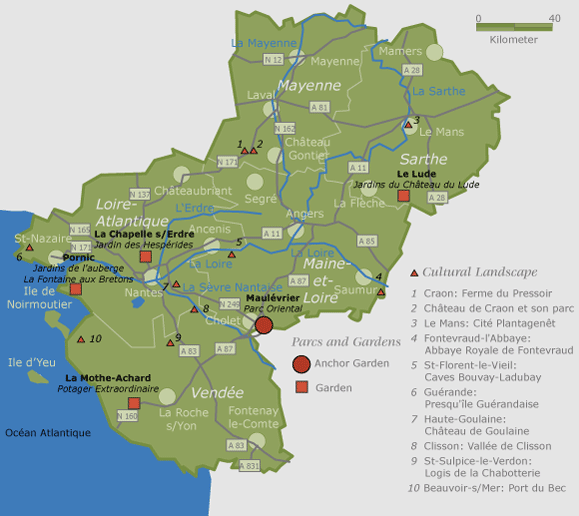 Gastronomy and the Art of Living in the Gardens of the Western Loire Valley
Gastronomy and the Art of Living in the Gardens of the Western Loire Valley
Discovering the art of living in Pays de la Loire is a treat for all five senses.
You are invited to look at the broad sweep of the landscape, the many monuments and the fertile vineyards which characterise the region.
Why not listen and be charmed by the soft murmuring of the streams and rivers, the ebb and flow of the tides, the sweet sound of birdsong in the gardens and woods and the rhythm of the church bells, not to mention the songs and concerts which are typical of the region.
Run your hand lightly over the old stones and plants and feel your sense of touch develop and grow.
Savour the scents of nature and its numerous gardens, on the one hand, and the aromas of quality foodstuffs, on the other.
And, last but not least, taste the fruity, sweet, dry or sparkling white, red or rosé wines, the mead, the fish from the Atlantic and the rillettes. All of these are a feast for the tastebuds.
In this region, the art of living and a sense of closeness to home are closely linked to cultural heritage and garden design. Allow yourself to be surprised and delighted by this heavenly region in the “garden of France”, where the art of living and nature meet.
You will discover French and English gardens, fountains, fruit and vegetable gardens and orangeries. The parks and gardens are not only testimony to the long-standing art of garden design, but also a quintessential part of the region’s identity. Classical parks and gardens which remain linked to the old traditions of still-inhabited castles thus await you in all their splendour. Local products are also available in each garden, so enjoyment is guaranteed.
The richness of the western Loire valley comes from its historical heritage, natural landscape, food and drink, rivers and streams and the nearby coast. With the gardens and parks as a starting point, a trip around the area offers an opportunity to discover and enjoy the art of living of the region at will.
The journey begins in Loire-Atlantique at the Château de Goulaine and the vineyards of Nantes. In La Vendée, you will visit La Chabotterie, a castle dating from the end of the 18th century, and “on the oyster route” you can learn about the secrets of oyster-growing. A welcome break can be had both at the royal abbey of Fontevraud in Anjou and at the numerous wine-makers such as Bouvet-Ladubay in the wine-growing region around Saumur. You can then sample gastronomic specialities of the Sarthe département at Bahier butchers, near Le Mans. The Château de Craon too invites you to enjoy famous specialities such as cider or pommeau. Finally, you return to the Atlantic coast and discover enchanting Breton traditions on the Guérande peninsula.
“Gastronomy and the art of living in the gardens of the western Loire valley” is a theme which relates both to culinary experience and to the five senses. It has been chosen by the regional committee for tourism in the Pays de La Loire in order to express the diversity of the region’s identity. Cultural heritage and landscape, architecture, antique furniture, regional products and not least garden design and garden culture combine here to form the core of a unique tradition and way of living.